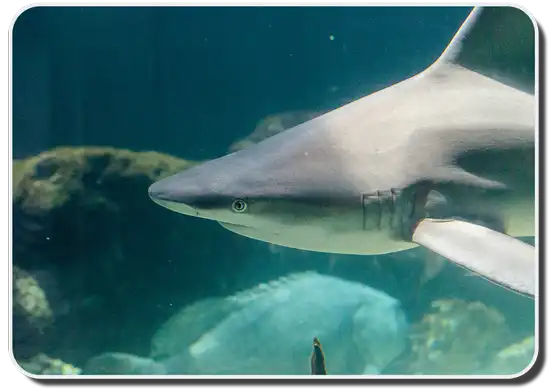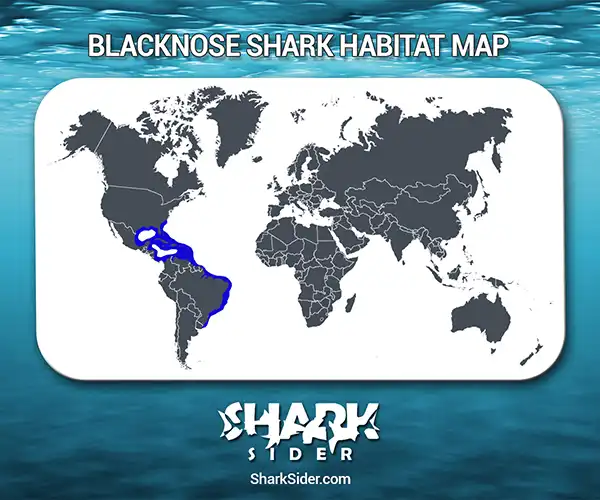Blacknose sharks are a species of requiem shark found through the western Atlantic Ocean. They get their name from the black spots on their noses, most notably noticed on the juveniles, though some adults also have the markings.

Blacknose Shark Scientific Classification |
|
| Kingdom | Animalia |
| Phylum | Chordata |
| Class | Chondrichthyes |
| Order | Carcharhiniformes |
| Family | Carcharhinidae |
| Genus | Carcharhinus |
| Scientific Name | C. acronotus |
Description
Blacknoses are generally 4.3–4.6 ft long and weigh about 22 lbs, with the record currently being 6.6 ft in length and 42 lbs in weight.
Their bodies are streamlined for maximum efficiency, with a long snout and a sickle-shaped first dorsal fin opposite the tapered pectoral fins. The second dorsal fin is across from the anal fin. Dermal denticles cover the entire body of the shark.
Inside the mouth of the blacknose shark, one can observe 12-13 rows of teeth on the upper jaw and 11-12 rows of teeth on the lower jaw. Each tooth is triangular and slightly slanted, with serrations. The teeth on the upper row are stouter than those on the lower one.
They have large eyes and nostrils covered with skin flaps controlling the flow of water taken in during inhalation. The shark has five short gills.
Blacknose sharks are brown, greenish-gray, or yellowish dorsally and yellow or white ventrally, with darker colorations observed at the tips of the second dorsal fin and the caudal fins. The juveniles have a black blotch on their snouts.
Where do they live
Map Of The Blacknose Shark’s Habitat

These sharks range from the coast of North Carolina in the United States to southern Uruguay, covering the Bahamas, the Caribbean Sea, and the Gulf of Mexico.
Blacknose sharks live in the continental and insular shelves, preferring coastal waters with coral rubble, sandy flats, and seagrass beds. Juveniles live in shallow water, while adults are commonly observed at depths of 59–210 ft.
Behavior
Hunting
They have a vast palette, with a diet consisting of cephalopods like octopi and small bony fish like anchovies, croakers, pinfish, porcupinefish, porgies, and spiny boxfish. These sharks use their speed to snatch away food from other larger sharks like the Caribbean reef shark.
Defensive
Blacknose sharks are often preyed upon by larger sharks. They will put on a threat display to ward off any possible danger by hunching their backs, lowering their pectoral fins, opening their jaws, and swimming in an exaggerated side-to-side way.
Social
These sharks are known to form schools of 6-8 individuals and follow mullets or anchovies.
Migratory
They migrate over short distances and exhibit philopatric behavior, i.e., return to the same place year after year. Both younger and fully mature sharks demonstrate this tendency.
Reproductive
Like other requiem sharks, the Blacknose is viviparous, giving live birth to 1-6 pups. The gestation period ranges from 8-11 months, with females mating throughout the year.
A newborn shark of this species is 15–20 in long, with the females growing slower than the males. This extends to sexual maturity, where males become capable of reproducing at 4-5 years while females become mature at 4-7 years. Females live longer at 11.5 years, while males only do so at 9.5 years.
Adaptations
They are built to swim very fast, with streamlined bodies and thin fins that “cut” through the water effectively.
Interactions with humans
These sharks are not dangerous and have not been known to bite humans. Still, if they begin to perform the threat display mentioned above, it is probably best to steer clear of them.
Overfishing is a threat to this shark, as it is a game fish captured by anglers for sport. Across the coasts of Brazil, Florida, and Venezuela, its meat is popular and sold dried and salted. Juvenile sharks often get caught as bycatch by shrimp trawlers, which poses a significant threat to the overall population. All these factors combined led the IUCN to classify this shark as “Endangered” or “EN”.
